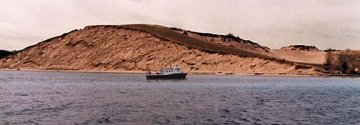Slip slidin’ away — under the sea
A thin layer of water can keep ocean avalanches moving far and fast.
Share this:
- Share via email (Opens in new window) Email
- Click to share on Facebook (Opens in new window) Facebook
- Click to share on X (Opens in new window) X
- Click to share on Pinterest (Opens in new window) Pinterest
- Click to share on Reddit (Opens in new window) Reddit
- Share to Google Classroom (Opens in new window) Google Classroom
- Click to print (Opens in new window) Print
An avalanche can send thousands of tons of rock and mud tumbling down a mountainside, wrecking everything in its way: trees, roads, bridges, buildings, and more. Eventually, the motion stops and the dust settles.
It can take much longer for debris to settle when an avalanche happens beneath the ocean. Underwater landslides can keep going and going—even along surfaces that are nearly flat. These huge, rolling masses of clay and silt sometimes wipe out plant and animal life over vast areas of the seafloor.
What keeps ocean avalanches on the move?
 |
|
In 1995, a large part of this bluff in the Sleeping Bear Dunes National Lakeshore suddenly disappeared beneath the waters of Lake Michigan in a huge landslide. U.S. Geological Survey scientists found a thick blanket of debris from the slide extending more than 2 miles offshore, much farther than expected. |
| USGS |
Norwegian scientists have used computers to help solve the puzzle. They figure that undersea avalanches travel far and fast because the moving sediment rides on a thin layer of water trapped between the sediment and the seafloor. This water layer cuts down the friction, letting the sediment keep sliding for long distances, sometimes at high speed.
Anders Elverhøi of the University of Oslo and his coworkers described their results in this month’s Journal of Geophysical Research—Oceans.
Something similar can happen to cars and trucks in wet weather. When traveling along a wet road, a car can lose its grip on the asphalt—making the car go into an uncontrollable slide. This loss of traction is known as “hydroplaning.” It’s caused by a layer of water between the tire and the road.
Hydroplaning might explain the size and reach of a massive avalanche known as the Storegga slide. It took place in the Norwegian Sea about 8,000 years ago. Enough sediment to make up several mountains broke free in that avalanche, and some of slid nearly 500 kilometers.
And, in a 1929 slide just south of Newfoundland, 300 to 700 cubic kilometers of sediment sped across the seafloor at nearly 80 kilometers per hour, snapping several transatlantic communication cables.
Crabs, shrimp, and Nemo, get out of the way! Once an underwater landslide gets going, there’s no stopping it until it’s moved a long, long way.
Going Deeper:
Perkins, Sid. 2004. Scooting on a wet bottom: Some undersea landslides ride a nearly frictionless slick of water. Science News 165(Jan. 23):84. Available at http://www.sciencenews.org/20040124/fob7.asp .
You can learn more about the coastal landslide at Sleeping Bear Dunes, Michigan, at wrgis.wr.usgs.gov/fact-sheet/fs020-98/ (U.S. Geological Survey).
Additional information about landslides is available at interactive2.usgs.gov/learningweb/
explorer/topic_hazards_landslides.asp (U.S. Geological Survey).







